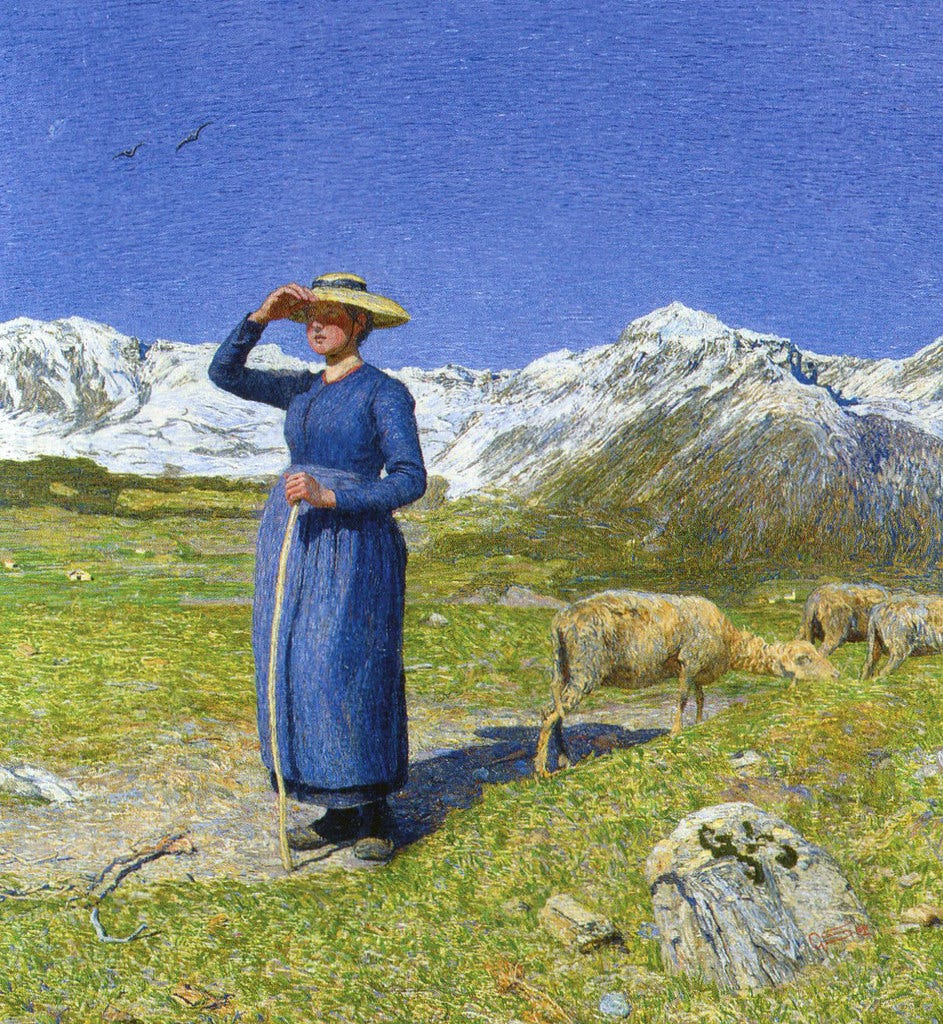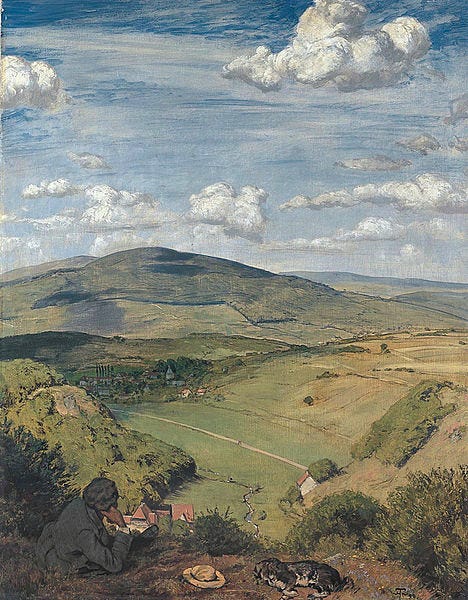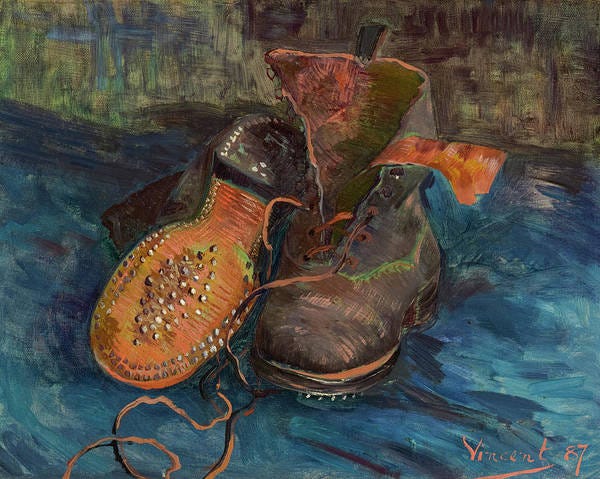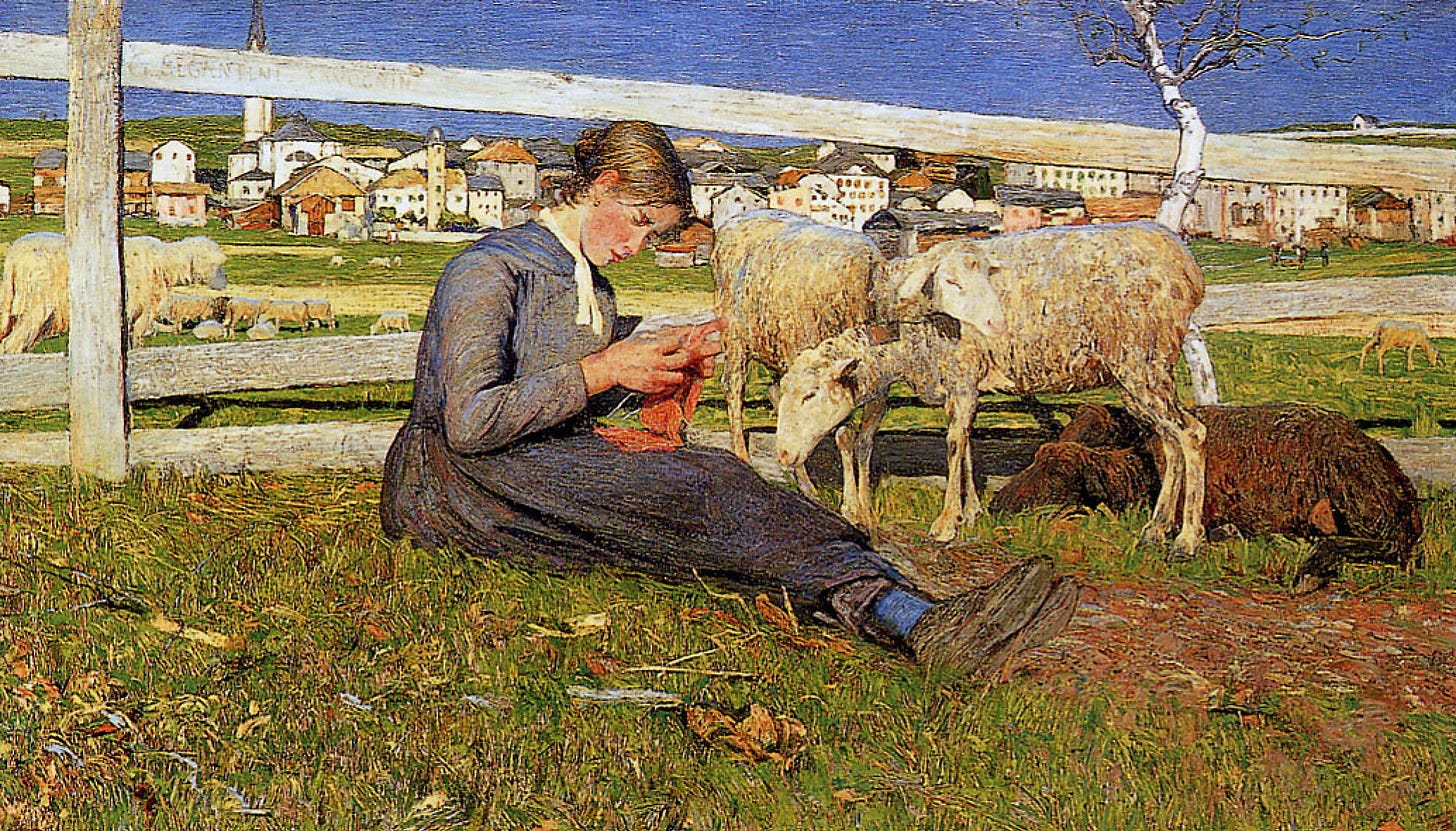This post serves as a continuation to From Feeding Moloch to ‘Digital Minimalism’ and a readying for the digital detox pilgrimage ahead. A hearty welcome to all new readers who have joined after reading Paul Kingsnorth’s latest piece from
and all others who have found their way here! Many thanks to and for encouraging their readers to consider joining in.Note: In keeping with the theme of ‘digital detox’, this post was written in a single draft Dickensian-style free-hand, and transcribed with only minor edits.
Almost twenty years ago I walked the Camino in Spain, from Leon to Santiago de Compostella. I did not set out on this pilgrimage trail as a Christian seeking repentance or solitude for prayer, but as an ambitious hiker looking for an out-of-the-ordinary experience. Frankly, I had come across the idea in the travel section of my Saturday newspaper and thought, “I’ll do that”. I did not expect that it would be the first step toward turning my life around.
In preparing for the trip it was essential to cut down on travel weight as much as possible; every gram mattered (or so expert hiker blogs informed me). Some pilgrims even went as far as breaking the handles off their toothbrushes, or ripping out pages of a book once they were read in order to reduce their load. Others clearly had not heeded any such advice, and brought along everything they could think of, including a tripod for their camera. They ended up paying the price for the added burdens, ruining their backs and shoulders, prompting some to abandon their pilgrimage early. Feet also had to be prepared, and needed to be diligently massaged with Vaseline so as to make the skin supple and less prone to blisters. Little wads of sheep wool tucked in rub spots, would serve to further protect a hiker’s most precious asset.
Prepare for your digital detox. What will you need and what can you leave behind? Set yourself specific usage rules. Being too vague or too strict can set you up for failure. Write down your own rules (on paper) for how and when you will allow yourself to use your phone, computer, or device. Retain only what is essential.
One station of the pilgrimage is the Cruz de Ferro, a tall post with an iron cross at the highest point of the trail between the towns of Manjarín and Foncebadón. Pilgrims traditionally bring a small stone, representing their burdens and sins, and throw it backward over their shoulder, rejecting their sins both in facing away from them, and physically throwing off a symbol of their burden. I had read about the practice and had brought along a shiny, black rock in preparation. Yet when I faced the cross, I kept it in my pocket and instead grabbed a pebble by the side of the path and skipped it at the cross. It was a deliberate rejection of forgiveness that I felt I didn’t need. Later around the dinner table with fellow hikers I quipped, “I like my sins.” It was the ultimate hubris.
Letting go of habits we know are destructive to us is terribly hard. While acknowledging the harms and rejecting the use of devices, you still may feel like you want to keep the rock in your pocket. Embrace this chance and (metaphorically) chuck this burden over your back. The freedom you will gain is worth the discomfort of letting go.
Although there was often jovial fellowship around shared dinner tables at refugios (government-run hostels), throughout the day most pilgrims walked in solitude. At the break of day, I looked forward to the sound of crunching of gravel under my feet and the rhythmic clicking of the hiking pole; it created a type of focused solitude. Walking alone, I never felt lonely; rather it helped me to think slowly and deeply, about anything and everything. Cal Newport’s quote by Wendell Berry perfectly reflects what I experienced at the time: “We enter solitude, in which we also lose loneliness.”
Solitude was one natural side-effect of walking. Another was the continuous immersion in the natural environment around me: Endless vistas of the tapering Pyrenees, mountain slopes covered in purple heather, eucalyptus tree groves, meadows speckled with cows and sheep, all suffused with their smells and sounds. The weather did not always make it a joy to be outside, at times the drizzle and cold wind of the mountainous trails would make me shiver to the bone, other times the sizzling heat of the sun-exposed trails was overwhelming. Yet the natural surroundings and the weather rendered me ever-present in the moment.
As I am writing from a pilgrim’s perspective, it only seems fitting to integrate a recent essay by
which includes a Pilgrim's Creed, "a brief, plain-language summary on how to maintain a Machine-resistant mentality." The creed serves as a compass to those who recognize that the relentless intrusion of digital tech in our lives is ever more eagerly eroding what makes us human. While it is written from a Christian perspective, readers from different backgrounds will find resonance with the need to define where humanity needs to draw the line, "in order to anchor us to our core meanings in life and situate technology’s proper place in the order of things."Pilgrim’s Creed, Article 5 – I believe we must stay in close contact with the primary elements of creation. Staying close to the primary creation keeps us within the right order.
Once the day’s walk was done, backpack thrown off, self and socks washed, it was time for engaging in a smorgasbord of conversations around the communal kitchen tables. Communication was rarely a barrier - most of us knew how to talk about knees, feet, and blisters in a multitude of languages, if not in Spanish, English, or French, then with hands and faces. Pilgrims hailed from all over the world: I spoke with hikers from Spain, Japan, the Netherlands, Canada, France, Germany, Brazil, the U.S., and Switzerland. We were vastly different in age and background - ranging from teenager to retiree, from gardener to youth court judge - but we shared the same daily walking activity, the same food, the same aches and pains. Every day we engaged with each other face-to-face; what tremendous connection this formed between us despite our differences.
Pilgrim’s Creed, Article 4 – I believe in real relationships within marriage, family, and local community, including people who are different from us. I recognize that virtual relationships exist, but their existence does not render real relationships arbitrary or dispensable.
When we are communicating on digital devices we are disembodied from space and time. It is the exact inverse of how to be in relationships.
Engage in analog relationships through face-to-face conversation. When meeting with a friend, suggest that you both power off your phone to give your ‘real time’ meeting precedence. This practice will serve to ‘re-humanize’ the parts of ourselves that have become diluted and disintegrated.
The first few days of walking were the toughest. Although I had prepared myself by hiking up and down Signal Hill in St.John’s (where I had been living at the time), I was in no way prepared for the endless inclines and descents which were devastating to knees and calves. When the hills got too steep, I looked down at my feet and the ground just in front of me. It was deceptively simple, but it worked to focus my mind on the doable. And after placing step after step after step, the crest which had seemed insurmountable was reached.
If you struggle with restlessness, anxiety, or boredom, focus on a task at hand, not on all the time remaining ahead of you. The longer you persist, the easier it will get.
The last day of the pilgrimage arrived with an exultant feeling. My steps were steady and firmly focused on their goal: to arrive in Santiago de Compostella in time for the pilgrim’s mass at noon. Unbeknownst to me, I had undertaken the pilgrimage during a holy year, and some fellow pilgrims encouraged me to come along and obtain my credencial. I was handed a document, sealed with official stamp and issued to my name, affirming that “all my sins had been forgiven”. At the time it was merely a tourist memento to me. I attended the service at the Archcathedral Basilica which is held for pilgrims at noon, the priest loudly announcing how many pilgrims had arrived that day along with their country of origin. As his voice boomed, the Botafumeiro thurible swung clouds of incense over our heads with frightening impetus.
The surprise to me was that although I felt elation at having arrived, I did not want to stop walking. I wanted to keep going. The rhythm, the solitude, the commraderie, and the simplicity were too beautiful to leave behind. There are pilgrims who, once having arrived, indeed turn around and walk all the way back home. I wished that I could have done the same. Instead I boarded a bus to Paris, and was on my way to visit my family in Switzerland. On a brief stop-over in the city of lights I meandered through the streets, trying to regain my walking feet. I was overwhelmed by all the noise, commotion, and hurry. How could people live like this? I feared that spending any amount of time in such a setting would undo all the silence and peace I had accumulated in myself.
At the end of the digital detox month, it is up to you to decide what technology you will allow back into your life, and to what extent it will be part of your daily routine. There is no reason why you cannot simply keep going. Some of you may, and find joy in continued ‘cognitive liberty’.
It would take another two years after my return from the pilgrimage for me to turn toward God. I was not looking to find Him at all. It was a devastating recognition that good and evil exist, and that I had veered onto the dark side by not making a clear choice. I was tangled up in lies and deception, and it was suffocating. I felt as though I was encased in a shroud of sticky tar. As I came to the decision that the truth would indeed set me free, the oppressive darkness sloughed off me like a withered shadow. I had made my choice.
I think back now to this experience in light of the encroaching, ominous darkness that surrounds the Machine. It can feel oppressive, inescapable, and render one hopeless. Yet the Machine on its own is a vapid non-existence; its only power lies in our participation of its non-reality. I believe that making a clear choice to reject the invasion and erosion of our basic humanity is like deciding to step onto the side of truth. This choice does not destroy the Machine, but with it we refuse to offer ourselves up as a ready dwelling place.
Just as Christians practice confession (whether with a priest, a spouse, or in prayer) to prevent darkness from settling in our soul, continually examining our use of digital technology helps to orient us to path of cognitive liberty.
Pilgrim’s Creed, article 8 – I believe in cognitive liberty, which is the freedom to concentrate, reason, remember, feel, imagine, perceive, and use language, without manipulation or control by others or technology.
If you find yourself nodding inwardly to these thoughts, I would like to encourage you to join in community for the digital detox for the month of May.
recently wrote about a guiding ethos that simply stated, "Any idea is only as good as its physical or tangible manifestation."If we ask, “how can we dare hope to maintain our humanity?”, then we will need to actually translate our ideas into tangible actions. From our individual actions we do not need to expect sweeping societal change, but we have to start somewhere. I believe in the fundamental power of face-to-face conversation around a kitchen table. One of the most earthshattering changes in history did not come to pass through political action, institutional change, or mass demonstrations; it was proceeded by a meal around a dinner table, sharing bread and wine.
To those who are about to embark on the ‘digital detox pilgrimage’ along with me, I wish you steady feet, an open heart, and a clear mind. Or as the pilgrims in Spain would say:
Buen Camino!
An Invitation to Join the ‘Digital Detox’ Community
Committing to a digital detox is a challenging step to take, especially if you do so alone. When we commit together with others, it helps to strengthen resolve and makes success more likely. If you have not yet read From Feeding Moloch to 'Digital Minimalism', I recommend that you read the ‘game plan’ section as it contains detailed practical guidance1.
I would like to invite readers to join in a ‘community digital detox’ from May 1st to May 31st2. If you would like to join others in taking this leap, reply with a brief note in the comment section below. For the month of May write down (preferably on paper) what worked for you and what made you slip.
During your ‘digital detox’ month make it your goal3 (in no particular order) to:
1. Create one beautiful thing
2. Read one book
3. Go for one two-hour walk
4. Visit one family member you have not seen in a while
5. Meet with one friend for a face-to-face conversation
6. Reach out to one neighbor
7. Cook one new meal
8. Engage in one new physical activity
9. Do one thing to make your home more beautiful
10. Leave your phone at home for one outing
At the end of May, I will invite readers to share their experiences4 and will compile an essay of ‘cognitive liberty’ practices that worked, the books that were read, the meals that were cooked, and the beautiful things that were created.
If you found this post helpful, consider supporting my work by ‘tiping’ a one-month subscription, or simply show your appreciation with a ‘like’ or a ‘share’.
If you would like to download and print the digital detox game plan you can do so here. The pdf document at the end of the post includes a (very) simple note page where you can plan your specific usage rules for the month.
Please feel free to join the detox at any point. The month of May merely serves as a common starting point for the 30-day digital detox.
If you are not yet ready for a detox, joining in any one or more of the simple goals below is a step toward reality and a step away from the Machine.
If you have decided to join the community digital detox and write your own substack, consider recording your experience and publishing it as a post to encourage your readers towards ‘cognitive liberty’.









Thanks for the shout out!
It’s amazing how you can just tell if something was written freehand first versus the whole process being screen mediated from start to finish. It’s certainly something I’ve noticed with my own work- the way you think is different with a pen in hand and no facility to cut and paste and move whole paragraphs around.
That said this was excellent and (like many others I’m sure) I’m glad Paul Kingsnorth pointed me in your direction.